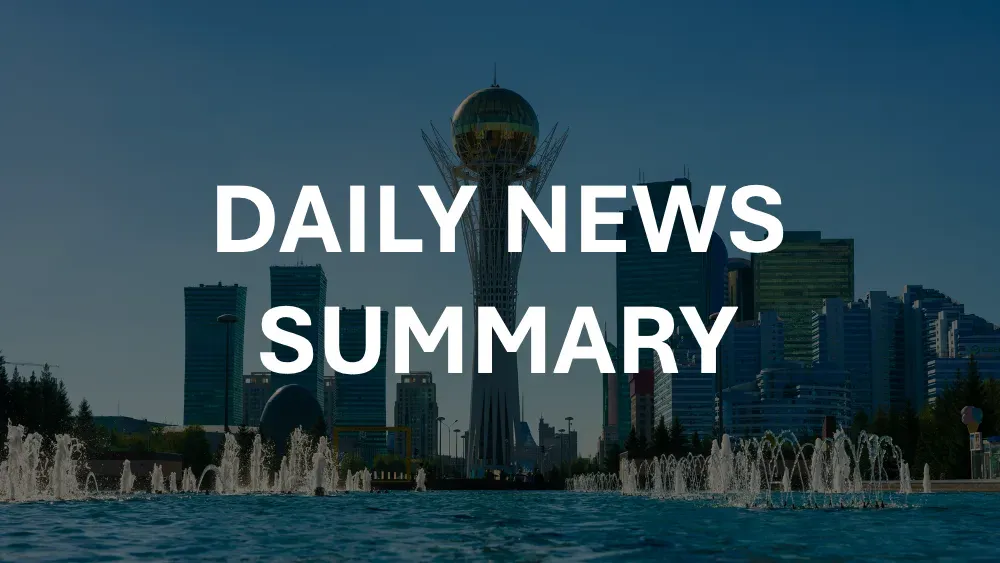📍 Get daily intelligence from Kazakhstan and Central Asia. Lexica News delivers local news that shapes global decisions—synthesized from local sources international media misses.
Kazakhstan achieved a historic milestone in 2024, recording $15.7 billion in foreign direct investment, representing an 88% increase from the previous year and the highest figure in the country's post-Soviet history. This surge positions Kazakhstan as the dominant investment destination in Central and Northern Asia, accounting for 63% of the region's total investments. The achievement reflects systematic reforms, regulatory improvements, and strategic positioning that have transformed Kazakhstan's investment landscape since President Tokayev's administration launched comprehensive economic liberalization measures.
International investors are responding to tangible policy changes, streamlined procedures, and expanded sectoral opportunities. The World Bank data shows investment expanded by 7.5% in real terms in 2024, while the government's new Investment Policy Concept targets $150 billion in cumulative FDI by 2029. This analysis examines the current investment climate, documented investor experiences, regulatory realities, and comparative regional performance to provide market intelligence for international professionals evaluating Kazakhstan's business environment.
Current Investment Landscape
Kazakhstan's investment surge reflects both cyclical factors and structural improvements implemented over recent years. The National Bank of Kazakhstan reports that gross FDI inflow reached $16.3 billion for January-October 2024, with 49 investment projects implemented, creating 17,828 new jobs. This represents a fundamental shift from previous patterns, where FDI flows remained volatile and concentrated in extractive industries.
The sectoral composition shows continued dominance of traditional industries alongside emerging diversification. Mining and hydrocarbon sectors attracted $6.4 billion, representing 51.6% of total FDI stock through October 2024. However, non-extractive sectors demonstrated significant growth, with retail trade and vehicle repair receiving $5.3 billion, reflecting international retailers' expanding interest in Kazakhstan's consumer market.
The European Bank for Reconstruction and Development identifies manufacturing (8.3% of FDI stock) and financial services (13% of FDI stock) as emerging growth areas. These sectors benefit from government incentives, improved regulatory frameworks, and Kazakhstan's strategic position linking Asian and European markets.
Geographic distribution reveals investment concentration patterns that reflect both infrastructure development and market access considerations. Almaty leads with $5.8 billion in FDI, functioning as Kazakhstan's financial and commercial hub. The capital's dominance stems from established financial infrastructure, skilled workforce availability, and proximity to major consumer markets.
Regional disparities persist despite government efforts to promote balanced development. The Ministry of National Economy reports that western regions, particularly those with oil and gas resources, continue attracting energy sector investments, while manufacturing investments cluster around existing industrial centers and special economic zones.
Documented Investor Experiences
Foreign investors report mixed experiences navigating Kazakhstan's evolving regulatory environment. EY's 2024 Investment Attractiveness Survey documents that 46% of companies not yet operating in Kazakhstan plan to begin operations in 2025, indicating continued investor confidence despite ongoing challenges.
Major international companies demonstrate varying adaptation strategies to Kazakhstan's business environment. Royal Dutch Shell, Chevron, and ExxonMobil continue expanding operations in the Tengiz and Kashagan oil fields, benefiting from established relationships and favorable production-sharing agreements. These companies report successful navigation of regulatory requirements through dedicated government relations teams and local partnerships.
Manufacturing sector investors document different experiences, particularly regarding regulatory compliance and workforce development. The World Bank's 2023 Jobs in Kazakhstan report highlights skill shortages and labor market mismatches as persistent challenges affecting non-mining activities. Companies investing in manufacturing report requiring 6-12 months for workforce training programs to achieve operational efficiency.
Technology sector investors benefit from specialized support mechanisms. Companies establishing operations through Astana Hub report streamlined registration processes, with business setup completed within 1-2 weeks compared to traditional 30-day procedures. These companies access simplified visa procedures for foreign specialists and favorable tax treatment for software development activities.
Financial services investors navigate complex regulatory requirements but benefit from growing market opportunities. The Astana International Financial Centre (AIFC) provides English common law jurisdiction, independent regulatory framework, and 50-year tax preferences. Companies operating through AIFC report reduced regulatory compliance costs and simplified cross-border transaction procedures.
Retail sector investors document rapid market expansion opportunities offset by logistical challenges. International retailers report consumer spending growth of 9.1% year-on-year in real terms in 2024, supporting expansion decisions. However, companies cite distribution network development costs and regional infrastructure limitations as ongoing challenges.
Stakeholder Realities
Government statistics and business experiences reveal gaps between official projections and operational realities. Official FDI data shows strong gross inflows, but net FDI figures present a more complex picture. Between January and September 2024, net FDI inflows dropped to $72.9 million from $2.3 billion in 2023, reflecting significant capital outflows including profit repatriation and loan repayments to foreign parent companies.
Local business associations report improved dialogue with government agencies but continuing bureaucratic challenges. The American Chamber of Commerce in Kazakhstan documents that member companies experience reduced inspection burdens following the removal of over 10,000 unnecessary business requirements since 2023. However, businesses report that digitalization initiatives sometimes increase rather than reduce administrative complexity.
Foreign investors express concerns about government intervention in business operations. The U.S. State Department's 2024 Investment Climate Statement notes government preferences favoring domestic companies, particularly in procurement processes, and increasing regulatory intervention in foreign companies' operations. Companies report uncertainty regarding contract stability and regulatory predictability.
Banking sector stakeholders document improving financial infrastructure alongside persistent challenges. The National Bank of Kazakhstan maintains foreign reserves exceeding $45.8 billion, covering seven months of imports, providing currency stability that investors value. However, businesses report limited access to long-term local currency financing and complex foreign exchange procedures for certain transactions.
Labor market stakeholders identify workforce development as a critical constraint. The Ministry of Labor's Workforce Development Center acknowledges skill shortages in technical fields, while businesses report difficulty recruiting qualified personnel outside Almaty and Nur-Sultan. Companies invest significantly in training programs, with some reporting training costs representing 3-5% of first-year operational budgets.
International development organizations recognize Kazakhstan's reform progress while noting implementation challenges. The OECD Investment Committee acknowledges improvements in investment policy frameworks, while the IMF notes that structural reform implementation remains slow and state footprint continues growing in some sectors.
Understand Kazakhstan Like an Insider
This analysis draws from extensive research, but the story continues to evolve daily. Lexica synthesizes breaking developments from dozens of Kazakh news sources—from mining policy changes to local protests that never make international headlines.
Our daily intelligence briefs help executives, diplomats, and researchers track:
- Regulatory shifts affecting foreign investment
- Local opposition to development projects before they escalate
- Market dynamics that signal opportunity or risk
- Political developments that reshape the business landscape
Operational Investment Context
Investment project implementation reveals specific cost structures and timeline realities that differ from initial projections. The Development Bank of Kazakhstan provides reduced-rate infrastructure financing, but companies report project approval processes extending 6-18 months for complex investments requiring multiple agency approvals.
Business registration demonstrates improved efficiency alongside remaining complexities. Foreign investors can complete legal entity registration within 1 working day for standard business structures. However, companies requiring special licenses or permits report additional 2-6 month approval periods depending on sector and investment size.
Tax administration presents mixed experiences across different investor categories. Companies operating in Special Economic Zones report streamlined tax procedures and exemptions, with corporate income tax reduced by 100% for priority activities. Businesses outside SEZs report standard corporate tax rates of 20% with additional complexity regarding transfer pricing and international transaction documentation.
Foreign workforce permissions reflect both liberalization and constraints. The Astana Hub provides simplified procedures for IT specialists, while other sectors report 3-6 month approval periods for foreign worker permits. Companies document annual costs of $2,000-5,000 per foreign employee for visa and permit procedures.
Currency convertibility operates smoothly for most transactions but includes specific restrictions. Kazakhstan's legislation permits non-residents to freely transfer dividends, interest, and other income without time limitations. However, companies report documentation requirements for transfers exceeding $100,000 and periodic changes in reporting procedures that require ongoing compliance attention.
Investment incentive realization varies significantly based on sector and project characteristics. Priority sector investments receive 25-year legislative stability guarantees for projects exceeding $50 million, while smaller investments navigate standard regulatory environments. Companies report incentive approval processes requiring 3-12 months with extensive documentation requirements.
Regional Investment Comparison
Kazakhstan's investment performance relative to regional peers demonstrates both competitive advantages and ongoing challenges in Central Asia's evolving investment landscape. The Asian Development Bank projects Kazakhstan's GDP growth at 3.8% for 2024, outperforming most Central Asian economies while trailing dynamic Asian markets.
Uzbekistan presents the closest regional comparison, with both countries implementing significant economic reforms under new leadership. Uzbekistan attracted approximately $7 billion in FDI commitments during 2024, significantly lower than Kazakhstan's $15.7 billion but representing substantial growth from previous years. Uzbekistan benefits from lower labor costs and a larger domestic market, while Kazakhstan offers superior infrastructure and established international business frameworks.
Kyrgyzstan and Tajikistan operate in different investment categories, attracting primarily regional investments and development financing. World Bank data shows these countries receiving FDI flows of $200-500 million annually, focusing on mining, agriculture, and hydroelectric projects. Kazakhstan's investment scale reflects its larger economy, energy resources, and more developed financial systems.
Russia's investment climate deteriorated significantly following 2022 international sanctions, creating opportunities for Kazakhstan as companies seek alternative regional locations. Some Western companies report relocating operations from Russia to Kazakhstan, though this trend remains limited by concerns about secondary sanctions and political stability.
China represents both an investment source and competitive benchmark for Kazakhstan. Chinese companies invested $6.2 billion in Kazakhstan over the past five years, primarily in energy and infrastructure sectors. Kazakhstan's investment climate offers greater transparency and rule of law compared to some Central Asian neighbors, though administrative efficiency remains below Chinese standards.
Turkey and the UAE emerge as important investment sources and regional benchmarks for investment facilitation. Both countries operate investment promotion agencies with streamlined procedures that Kazakhstan studies for best practices. The UAE's investment in Kazakhstan focuses on logistics and financial services, benefiting from geographic positioning and established commercial relationships.
Conclusion
Kazakhstan's $15.7 billion FDI record in 2024 represents genuine transformation in the country's investment landscape, driven by systematic reforms, expanded sectoral opportunities, and favorable external conditions. The 88% increase from previous year levels demonstrates that international investors respond positively to predictable policy frameworks and streamlined administrative procedures. However, the contrast between gross and net FDI flows reveals the complexity of established market dynamics, where profit repatriation and loan repayments offset new investment inflows.
The investment climate analysis reveals a country in transition, with significant improvements in regulatory frameworks, digital procedures, and sectoral diversification accompanied by persistent challenges in bureaucratic efficiency, workforce development, and regulatory predictability. Foreign investors document successful navigation of Kazakhstan's business environment through dedicated local expertise, strategic partnerships, and patience with administrative processes that remain more complex than international best practices.
Regional positioning analysis shows Kazakhstan maintaining competitive advantages in Central Asia through superior infrastructure, legal frameworks, and market access, while continuing efforts to match efficiency standards of more developed economies. The government's Investment Policy Concept targeting $150 billion in cumulative FDI by 2029 reflects ambitious but achievable objectives if current reform momentum continues and structural challenges receive sustained attention.
Current data trends indicate investment flows will likely continue growing, though possibly at more moderate rates as base effects diminish. Key metrics worth monitoring include net FDI flows versus gross figures, sectoral diversification progress beyond traditional extractive industries, and administrative efficiency improvements as digitalization initiatives mature. The sustainability of Kazakhstan's investment attraction success depends ultimately on implementation consistency and continued reduction of regulatory uncertainty that international businesses consistently identify as primary concerns.
Frequently Asked Questions
What factors drove Kazakhstan's record $15.7 billion FDI performance in 2024?
The record FDI reflects multiple converging factors: systematic regulatory reforms, expanded sectoral opportunities, political stability under President Tokayev, and favorable commodity markets. The government's Investment Policy Concept 2024-2029 created predictable policy frameworks, while geopolitical developments increased Kazakhstan's attractiveness as companies sought alternatives to other regional markets. Strong domestic demand growth of 9.1% and currency stability supported investor confidence.
How reliable are Kazakhstan's FDI statistics compared to actual investment flows?
Official gross FDI figures of $15.7 billion reflect genuine investment commitments, but net FDI tells a different story. Net inflows dropped to just $72.9 million in January-September 2024 due to significant profit repatriation and loan repayments to parent companies. This pattern is typical for maturing resource-based economies where established investors generate returns while new investments continue flowing in.
What are the actual costs and timelines for establishing operations in Kazakhstan?
Standard business registration completes within 1 working day, but comprehensive project setup typically requires 6-18 months for complex investments. Companies report total setup costs ranging from $50,000-500,000 depending on sector and scale. Foreign workforce permits add 3-6 months and $2,000-5,000 per employee annually. Special Economic Zone registration reduces timelines to 2-4 months with significant tax benefits.
How does Kazakhstan's investment climate compare to regional alternatives?
Kazakhstan offers superior infrastructure, legal frameworks, and market access compared to other Central Asian countries, though at higher operational costs. The country provides greater regulatory predictability than Russia post-2022, more developed financial systems than Uzbekistan, and better international connectivity than smaller regional economies. However, bureaucratic processes remain slower than Gulf or East Asian alternatives.
What sectors offer the most realistic opportunities for new foreign investors?
Non-extractive sectors show strongest growth potential: retail/consumer goods (benefiting from rising domestic demand), financial services (through AIFC), manufacturing (via SEZ incentives), and technology (through Astana Hub). While mining remains dominant, new investors face high entry barriers and capital requirements. Service sectors offer more accessible entry points with growing market opportunities.
What are the main risks facing foreign investors in Kazakhstan currently?
Key risks include regulatory unpredictability despite recent reforms, currency volatility linked to commodity prices, limited skilled workforce outside major cities, and potential secondary sanctions concerns. Political risk remains moderate but stable under current leadership. Companies also cite corruption in certain sectors, though transparency initiatives show improvement. Infrastructure limitations affect regional operations outside main commercial centers.
How effective are Kazakhstan's investment incentives in practice?
Investment incentives deliver substantial benefits when properly navigated but require significant administrative effort to obtain. SEZ benefits include 100% corporate tax reduction and duty-free equipment imports. AIFC provides 50-year tax preferences and English law jurisdiction. Priority sector investments receive 25-year legislative stability for projects exceeding $50 million. However, companies report 3-12 month approval processes with extensive documentation requirements.
Track Kazakhstan with Local Intelligence
The rare earth story exemplifies why local sources matter. While international media reports MOUs and ministerial visits, Kazakh outlets cover the community protests, water disputes, and regulatory changes that actually determine project outcomes.
Lexica delivers what you're missing:
- Daily briefs at 7AM Astana time covering 40 top stories from politics to economics
- Full-text synthesis from sources in Kazakh
- Searchable archive to track how today's announcements connect to yesterday's promises
- Multi-country coverage across Central Asia for regional context
Whether you're evaluating investment opportunities, monitoring supply chain risks, or analyzing geopolitical developments, local intelligence reveals what international headlines obscure.










